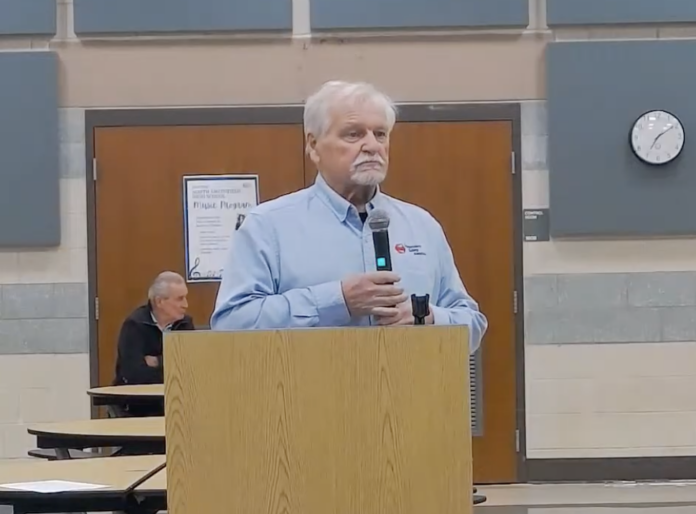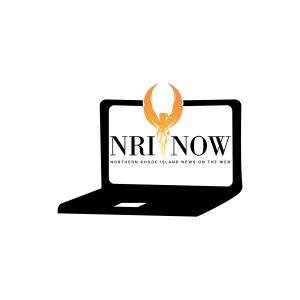NORTH SMITHFIELD – In testimony over the past month from a team of professionals hired by Material Sand & Stone, councilors and residents have heard reassurances that despite their concerns, operations at the Pine Hill Road quarry are consistently following well-monitored safety procedures governed by state and federal law.
Now, that paid for expert testimony will be evaluated by a second group of professionals – independent specialists chosen by the town.
The decision by the Town Council Monday night marks a new phase in the evaluation of Material Sand’s request for a zone change to accommodate an ongoing gravel extraction business through creation of a new “Industrial Special Management District 1 Overlay,” where mining is allowed in North Smithfield.
Councilors continued a public hearing on the application to Monday, May 5, with plans to hire experts to look over extensive information presented by a team representing the business – also known as Pound Hill Realty – over their past three meetings.

The unusual zone change request comes following a 2023 Superior Court order that the business follow the town’s process and pursue local administrative remedies after decades of unresolved litigation. A previous Town Council banned earth extraction in all town zoning districts in 1979, but exempted existing businesses as long as the subject property was acquired or leased prior to the effective date of the ordinance.
The mining company – long owned by the Pezza family – had been in operation since the 1950s. But the business acquired a second 32-acre lot in 1987 and merged the properties, an action then challenged by the town’s zoning official that would become the subject of years of legal wrangling. In the meantime, mining has continued and expanded without proper local permitting.
Creation of the new zoning district has been presented as a solution that would create more transparency and allow the town some say in operations that the business contends are allowed by right, with hours of testimony from experts regarding the safety of running a mine over the 89-acre site, which is situated above an aquifer adjacent to an EPA-monitored Superfund property.
At the council meeting on Monday, March 17, William Landry, an attorney representing Pound Hill Realty, presented Michael Hammond, who worked for a decade inspecting such operations for the federal Mine Safety Health Administration.
“Every mine gets an inspection every five years,” said Hammond, adding that the businesses were never warned in advance that he’d be coming. “These are all surprise inspections.”
Hammond noted that he inspected some 800 to 900 mines during his time with MSHA between 2010 and 2020, measuring how much silica the workers were exposed to. Inhaling silica dust can lead to a lung disease called silicosis, and Hammind said if anyone were to get it from the facilities, he would have.
“I was just breathing the air in the mine sites,” he said.
“Silica’s everywhere,” said Hammond, noting the dust comes from everything from concrete and granite countertops, to beach said. “I don’t remember ever having a sand and gravel pit that went over.”
Hammond was the third in a series of professionals to appear before the council, with testimony also provided before the Planning Board, where the business is hoping to obtain a positive recommendation for their zoning request. Last week, planners continued their evaluation to Thursday. April 10, a date Landry said may now be reconsidered in light of the council’s actions on Monday.
“I think we’re going to find out whether that’s feasible or not,” he said.
The board also continued to hear from residents this week, although far less were in attendance than when the hearings first began in February.
Resident Robert Belhumeur said that a seismologist hired by Material Sand, Richard Groll, has continuously told him that blasts from the operations fall well within the legal guidelines, even though the activity has left cracks in his walls and damaged the well of his home on Old Oxford Road.
“We listen to all these experts… they don’t live here,” said Belhumeur. “I just don’t understand you guys. How you can even contemplate on doing this? You’re going to make an industrial zone over my area? Over the aquifer? This doesn’t even make sense.”
Resident Richard Grubb warned councilors that the issue that should be their focus was getting lost in the details.
“To me, the crux of the problem is upstream,” said Grubb. “They go away if you agree that the lots cannot be combined. If we agree they can’t combine the lots, than we don’t have to spend money on an air and water study because we can just safely say ‘no.'”
“We’ve had a zoning ordinance since 1979 that this quarry has ignored,” said Grubb.
The decision to pursue an independent peer review was proposed on Monday by Councilor John Beauregard, who noted that by May, the council should also have their recommendation from planners.

“Who knows – they may turn around and say everything that they heard was exactly right, or they may oppose a couple of different comments that were made,” said Beauregard. “Either way, we should have our own experts. It’s been said many times.”
Councilor David Punchak questioned who would fund the evaluation.
“I think it’s money well spent to give everybody the peace of mind that what we’re hearing is correct,” Beauregard said.
Punchak noted that the step will be part of a review of the business’s request – and asked Landry if his client would be willing to fund it.
After a recess to speak with Material Sand President Robert Pezza, Landry said they would welcome the opportunity for their experts to be peer reviewed.
“If there’s something we missed or something we could be doing better, we’re interested in knowing that as much as you are,” Landry said. “We’re willing to be involved in the financing of that.”
The attorney asked that Town Planner Mark Carruolo choose the professionals.
“He’s used to retaining experts at the Planning Board level,” said Landry. “We have to be able to make sure that the experts are truly experts. My clients will reimburse that cost if it’s fair and routine.”
Town Solicitor David Igliozzi agreed.
“I think the cleaner thing to do is have the planner do it,” said Igliozzi. “He does it all the time for the Planning Board.”
Beauregard said he’d prefer if the company didn’t pay.
“That’s my opinion,” he said. “I think that his offer to pay is generous and I appreciate that. We should keep everything separate.”
Both Landry and Igliozzi noted that such reimbursement is frequently a routine part of applications before planning.
Punchak made a motion for Carruolo to obtain experts that included acceptance of reimbursement, which councilors voted unanimously to approve.
Editor’s note: An original version of this article misspelled Michael Hammond’s name. We apologize for the error.








JP said: “Does anyone think for themselves anymore or is everything ran through AI ?
Sooner or later the machine is just going to be garbage in – garbage out…”
Correction: L&RR is in the Northeast quadrant and the WS&G site is in the western area, other than that, is there anything here of substance you can find fault with or dispute?
I mean other than a couple typos and my reversing the locations of WS&G and L&RR?
Have a nice day…..
Jason, I actually agree with your position and belief on the gravel mining operation.
I’m just tired of people “using AI” to articulate their thoughts (or the machines thoughts). No better way to further dumb down a society, remove independent and critical thinking as well as “shape beliefs” than using AI.
Remember the A stands for artificial which is also known as “fake”
Have a nice night
AI makes for a much better search engine. If one foolishly asks uninformed questions and does not supply the links to the pertinent data needed to gather info, it is an awful tool and can very easily lead one astray.
It takes a practiced mind and a lot of time formulating the questions, links and other pertinent data to be sure one gets accurate information out.
Also, using 2 or 3 AI engines with the same criteria and looking for inconsistencies helps narrow down the facts.
Once one has done that and compiles it into a response, a lot of time, energy and thought has been expended.
I am certainly against AI if one is only asking a unprepared question and C&P the result. That’s just lazy and stupid.
I won’t be using google or yahoo search engines going forward. They are outdated.
AI is the new way to research.
Thanks BL!!!
Does anyone think for themselves anymore or is everything ran through AI ?
Sooner or later the machine is just going to be garbage in – garbage out…
Pound Hill quarry in North Smithfield, Rhode Island, sits between two Superfund sites— Western Sand & Gravel (WS&G) and Landfill & Resource Recovery (L&RR)—let’s evaluate the risk-benefit considerations of allowing its continued operation, factoring in the Rhode Island Department of Environmental Management (RIDEM) issuance of OCI-AIR-22-57, the Mine Safety and Health Administration (MSHA) Event Number 6925213 dated February 2, 2023, and a document from the ERPA (not dropping the link as posts with links never get approved). This will build on the existing analysis of North Smithfield’s quarrying ban under Section 340-4.11(B)(12), its consistency with federal and state law, and enforceability.
1. Authority Under North Smithfield’s Home Rule Charter
North Smithfield’s Home Rule Charter, supported by Section 340-4.11(B)(12), explicitly prohibits “mining or quarrying operations” across all zoning districts unless expressly permitted elsewhere (which it isn’t per the District Use Regulations). The quarry’s location between two Superfund sites—WS&G to the east and L&RR to the northwest—amplifies the town’s authority to enforce this ban. Superfund sites, designated under the Comprehensive Environmental Response, Compensation, and Liability Act (CERCLA), indicate severe contamination requiring federal cleanup. The Comprehensive Community Plan (Section 212-8) emphasizes protecting groundwater and rural character, both at risk from quarrying near these contaminated zones. The Town Council’s legislative power under home rule justifies the ban to safeguard public health and the environment, especially given this unique geographic context.
2. Consistency with Federal Law
The ban aligns with federal law, as CERCLA prioritizes protecting human health and the environment near Superfund sites. Quarrying between WS&G and L&RR could exacerbate contamination risks (e.g., dust mobilizing pollutants or blasting affecting the groundwater flow), potentially conflicting with federal cleanup efforts. The MSHA Event 6925213 (February 2, 2023) documents a safety violation at Pound Hill related to operational hazards—reinforcing federal oversight concerns. While federal law doesn’t preempt North Smithfield’s zoning authority here (quarrying isn’t mandated under interstate commerce), continued operation could draw scrutiny if it undermines CERCLA objectives, supporting the ban’s consistency.
3. Consistency with State Law
Rhode Island’s Zoning Enabling Act (R.I. Gen. Laws § 45-24-27 et seq.) and Section 212-8 allow North Smithfield to tailor land-use rules to its Comprehensive Plan, which prioritizes environmental protection near sensitive areas like Superfund sites. RIDEM’s OCI-AIR-22-57 notice indicates an air quality violation, tied to fugitive dust exceeding state standards, consistent with R.I. Gen. Laws § 45-46-5 (soil erosion and sediment control) and RIGL 23-23-31 Fugitive Dust. The state permits stricter local rules under home rule, and the quarry’s proximity to WS&G and L&RR—both EPA & state-monitored sites—bolsters the ban’s alignment with Rhode Island’s environmental goals. No state law overrides this prohibition, as quarrying isn’t a protected activity.
4. Enforceability
The ban is enforceable via Section 340-5.1 (Building/Zoning Official oversight), Section 340-5.12 (fines up to $500 per violation), and judicial backing (Pound Hill Realty, LLC v. Town of North Smithfield, 2023). The quarry’s location amplifies enforcement urgency: violations like OCI-AIR-22-57 and MSHA 6925213 demonstrate ongoing risks, justifying stop-work orders or permit denials. The Superfund proximity adds legal weight—noncompliance could escalate to state or federal intervention, enhancing enforceability.
5. Risk-Benefit Analysis of Continued Operation
The Pound Hill quarry’s operation between WS&G and L&RR presents significant risks:
Environmental Risks: The OneDrive document likely details operational impacts (e.g., dust, noise, groundwater disruption), which OCI-AIR-22-57 confirms via air quality violations. Blasting or excavation could disturb contaminants (e.g., heavy metals, VOCs) from Superfund sites, risking migration into the Tarkiln Brook or nearby aquifers, as noted in Section 340-3.15 (Groundwater Aquifer Protection).
Health Risks: MSHA Event 6925213 suggests safety lapses, potentially exposing workers and residents to silica dust or structural hazards. Superfund proximity heightens exposure risks to legacy pollutants, conflicting with Section 340-1.2’s health protection goals.
Legal Risks: Continued operation post-violations could trigger RIDEM or EPA enforcement, escalating costs and liabilities for the town or operator.
Benefits are limited:
Economic output (jobs, gravel supply) is outweighed by cleanup costs if contamination spreads. The quarry’s nonconforming status under Section 340-4.9 suggests it predates the ban, but expansion is prohibited, capping economic upside.
Analysis: The risks—environmental degradation, health hazards, and legal exposure—far exceed benefits, especially post-OCI-AIR-22-57 and MSHA 6925213. The Superfund context amplifies these concerns, as quarrying could destabilize remediation efforts costing millions (e.g., WS&G’s PCB cleanup). North Smithfield’s ban, already enforceable, is a prudent response, and allowing operation would contradict Section 212-8’s conservation mandate and public welfare priorities.
Conclusion
North Smithfield’s Home Rule Charter, via Section 340-4.11(B)(12) and the District Use Regulations, legally bans quarrying, consistent with federal (CERCLA) and state (RIDEM) frameworks. Enforcement is robust through zoning mechanisms. Given Pound Hill’s location between WS&G and L&RR, alongside documented violations (OCI-AIR-22-57, MSHA 6925213), the risk-benefit calculus strongly favors cessation. Continued operation threatens environmental integrity, public health, and legal compliance, outweighing minimal economic gains, making the ban both justified and critical.
I had ChatGPT summarize to make it easier to read.
Summary – Pound Hill Quarry Risk-Benefit Analysis
1. Authority Under North Smithfield’s Home Rule Charter
-Section 340-4.11(B)(12) prohibits quarrying across all zoning districts.
-Proximity to Superfund sites (WS&G and L&RR) strengthens the town’s authority to enforce this ban.
-The Comprehensive Community Plan (Section 212-8) emphasizes protecting groundwater and rural character, supporting the ban.
-The Town Council has legislative authority to enforce the ban to protect public health and the environment.
2. Consistency with Federal Law
-CERCLA prioritizes protecting human health and the environment near Superfund sites.
-Quarrying could exacerbate contamination risks, undermining CERCLA cleanup efforts.
-MSHA Event 6925213 (Feb 2, 2023) documents safety violations, reinforcing federal oversight concerns.
-No federal law preempts North Smithfield’s zoning authority, supporting the ban’s validity.
3. Consistency with State Law
-Rhode Island’s Zoning Enabling Act (R.I. Gen. Laws § 45-24-27 et seq.) allows tailoring land-use rules to the Comprehensive Plan.
-RIDEM’s OCI-AIR-22-57 notice documents air quality violations, aligning with state environmental protection laws.
-State law permits stricter local regulations, with no state law overriding the ban.
4. Enforceability
-Enforcement mechanisms include:
-Section 340-5.1 (Building/Zoning Official oversight).
-Section 340-5.12 (fines up to $500 per violation).
-Judicial precedent (Pound Hill Realty, LLC v. Town of North Smithfield, 2023).
-Violations (OCI-AIR-22-57 and MSHA 6925213) justify stop-work orders and permit denials.
-Superfund proximity strengthens legal backing for enforcement.
5. Risk-Benefit Analysis of Continued Operation
-Environmental Risks:
-OCI-AIR-22-57 confirms air quality violations.
-Blasting or excavation may disturb Superfund contaminants, threatening Tarkiln Brook and
nearby aquifers.
-Health Risks:
-MSHA 6925213 suggests safety lapses, exposing workers and residents to silica dust and
pollutants.
-Legal Risks:
-Continued operation could trigger RIDEM or EPA intervention, increasing costs and
liabilities.
-Limited Benefits:
-Economic output (jobs, gravel supply) is outweighed by potential cleanup costs.
-The quarry’s nonconforming status (Section 340-4.9) limits economic upside.
6. Conclusion
-North Smithfield’s ban on quarrying aligns with federal (CERCLA) and state (RIDEM) laws.
-Enforcement mechanisms are strong, and continued operation poses unacceptable environmental, health, and legal risks.
-The risk-benefit assessment overwhelmingly supports cessation, making the ban justified and essential.